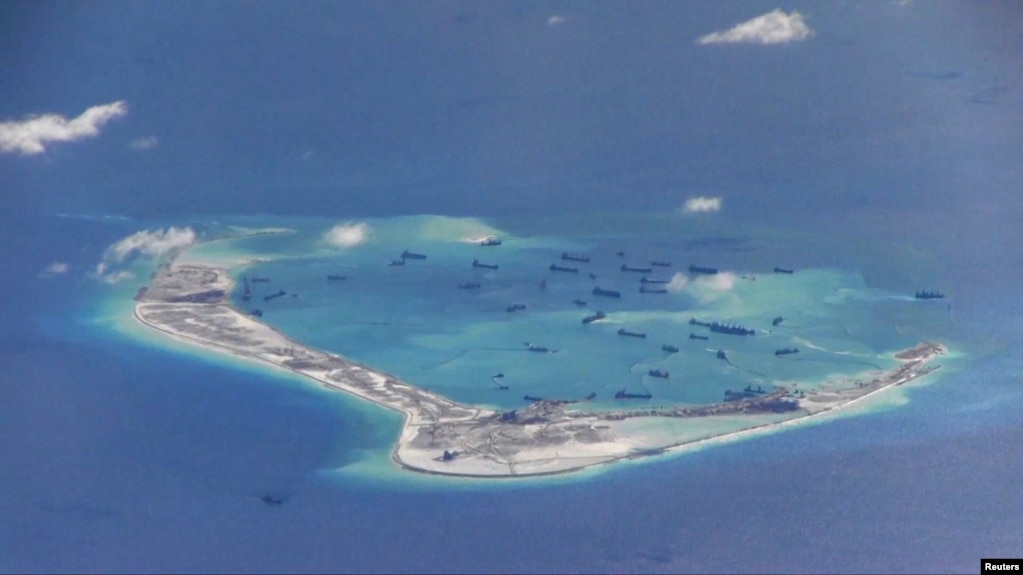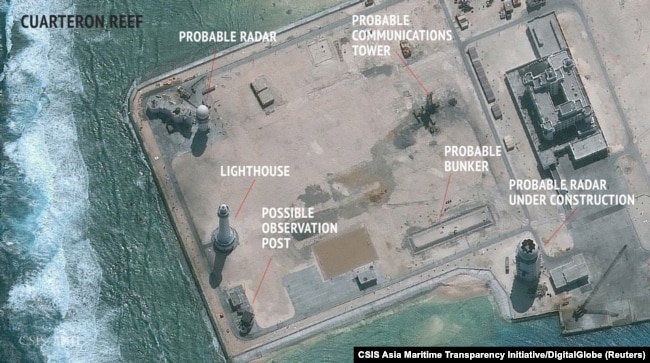By Joshua Fatzick

Chinese dredging vessels are purportedly seen in the waters around Mischief Reef in the disputed Spratly Islands in the South China Sea, May 21, 2015.
WASHINGTON — China is almost finished building military structures on its artificial islands in the South China Sea (SCS), Reuters reports, in a development that is sure to test the new Trump administration.
Unnamed U.S. officials told the news service construction is almost complete on nearly two dozen structures with retractable roofs designed to house long-range surface-to-air missiles on the Spratly Island chain.
The new development could be considered a military escalation on China’s part and could serve as an early test for Donald Trump, who took a hard line against China throughout his campaign.
“This is part of their effort to eventually control that first island chain in the SCS and assert their claim, even though they have been completely repudiated by the International Court of Appeals, The Hague, based on the Law of the Sea Treaty, of which they are a member,” Robert Manning, a senior fellow at the Atlantic Council, told VOA.
Brad Glosserman, executive director of the Hawaii-based security think tank Pacific Forum, told VOA this was another step in China’s recent attempts to further militarize the islands.
“Clearly, they are intending to build facilities that allow them to permanently store or deploy equipment of a military nature to these islands,” he said.
A report released by the Asia Maritime Transparency Initiative (AMTI) in December shows China has been building airstrips and anti-aircraft systems on the artificial islands since at least June of 2016.
The new development could be considered a military escalation on China’s part and could serve as an early test for Donald Trump, who took a hard line against China throughout his campaign.
“This is part of their effort to eventually control that first island chain in the SCS and assert their claim, even though they have been completely repudiated by the International Court of Appeals, The Hague, based on the Law of the Sea Treaty, of which they are a member,” Robert Manning, a senior fellow at the Atlantic Council, told VOA.
Brad Glosserman, executive director of the Hawaii-based security think tank Pacific Forum, told VOA this was another step in China’s recent attempts to further militarize the islands.
“Clearly, they are intending to build facilities that allow them to permanently store or deploy equipment of a military nature to these islands,” he said.
A report released by the Asia Maritime Transparency Initiative (AMTI) in December shows China has been building airstrips and anti-aircraft systems on the artificial islands since at least June of 2016.

An undated satellite image released by the Asian Maritime Transparency Initiative at Washington's Center for Strategic and International Studies shows construction of possible radar tower facilities in the Spratly Islands in the disputed South China Sea.
China's Defense Ministry issued a statement at the time, saying the construction was "mainly for civilian use."
The Trump administration has taken a strong stance against the militarization of the islands, with Secretary of State Rex Tillerson in January suggesting the United States block China from accessing the islands.
“We're going to have to send China a clear signal that, first, the island-building stops and, second, your access to those islands also is not going to be allowed," he said during his confirmation hearing before the U.S. Senate.
White House Spokesman Sean Spicer backed Tillerson up when asked about the comments, saying the United States needed to “protect our interests” in the South China Sea.
“It's a question of if those islands are in fact in international waters and not part of China proper, then... we're going to make sure that we defend international territories from being taken over by one country," Spicer said during a press briefing last month.
While the artificial islands could become a serious test of the Trump administration’s foreign policy, the islands weren’t designed with that intention, Glosserman said.
“It constitutes a test for this president, just as it constitutes a test for any president, but this was not done specifically to challenge Mr. Trump,” he said.
The Trump administration has taken a strong stance against the militarization of the islands, with Secretary of State Rex Tillerson in January suggesting the United States block China from accessing the islands.
“We're going to have to send China a clear signal that, first, the island-building stops and, second, your access to those islands also is not going to be allowed," he said during his confirmation hearing before the U.S. Senate.
White House Spokesman Sean Spicer backed Tillerson up when asked about the comments, saying the United States needed to “protect our interests” in the South China Sea.
“It's a question of if those islands are in fact in international waters and not part of China proper, then... we're going to make sure that we defend international territories from being taken over by one country," Spicer said during a press briefing last month.
While the artificial islands could become a serious test of the Trump administration’s foreign policy, the islands weren’t designed with that intention, Glosserman said.
“It constitutes a test for this president, just as it constitutes a test for any president, but this was not done specifically to challenge Mr. Trump,” he said.
“This was a determination that the Chinese had made about what they wanted to do, and that therefore they are going to proceed. It becomes a challenge, but it was not designed as such.”